2007 SUZUKI FORENZA lock
[x] Cancel search: lockPage 57 of 225
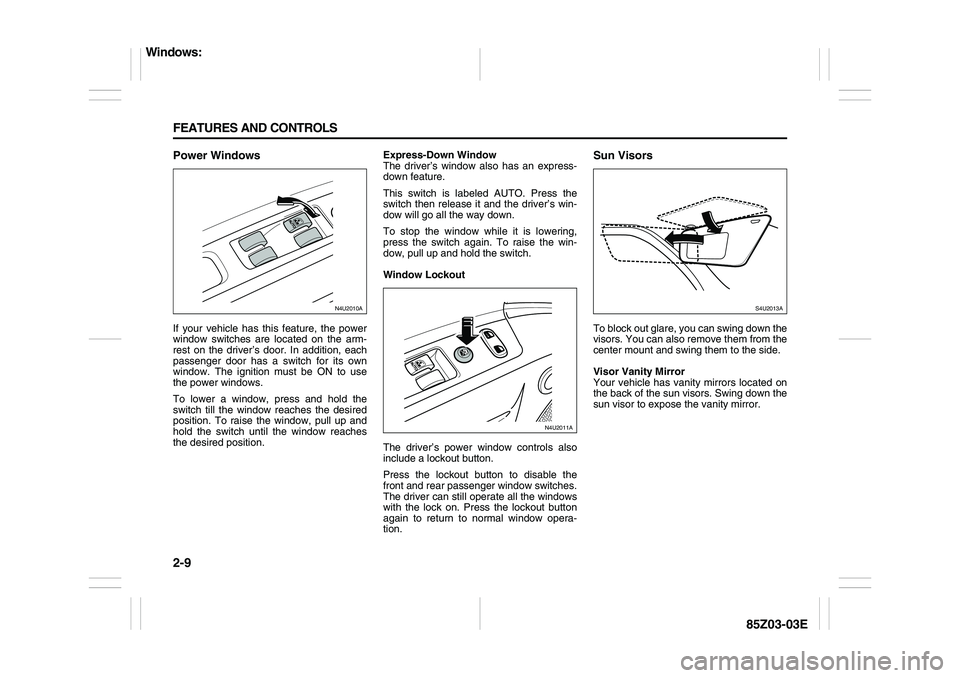
2-9 FEATURES AND CONTROLS
85Z03-03E
Power WindowsIf your vehicle has this feature, the power
window switches are located on the arm-
rest on the driver’s door. In addition, each
passenger door has a switch for its own
window. The ignition must be ON to use
the power windows.
To lower a window, press and hold the
switch till the window reaches the desired
position. To raise the window, pull up and
hold the switch until the window reaches
the desired position.Express-Down Window
The driver’s window also has an express-
down feature.
This switch is labeled AUTO. Press the
switch then release it and the driver’s win-
dow will go all the way down.
To stop the window while it is lowering,
press the switch again. To raise the win-
dow, pull up and hold the switch.
Window Lockout
The driver’s power window controls also
include a lockout button.
Press the lockout button to disable the
front and rear passenger window switches.
The driver can still operate all the windows
with the lock on. Press the lockout button
again to return to normal window opera-
tion.
Sun VisorsTo block out glare, you can swing down the
visors. You can also remove them from the
center mount and swing them to the side.
Visor Vanity Mirror
Your vehicle has vanity mirrors located on
the back of the sun visors. Swing down the
sun visor to expose the vanity mirror.
N4U2010A
N4U2011A
S4U2013A
Windows:
Page 58 of 225
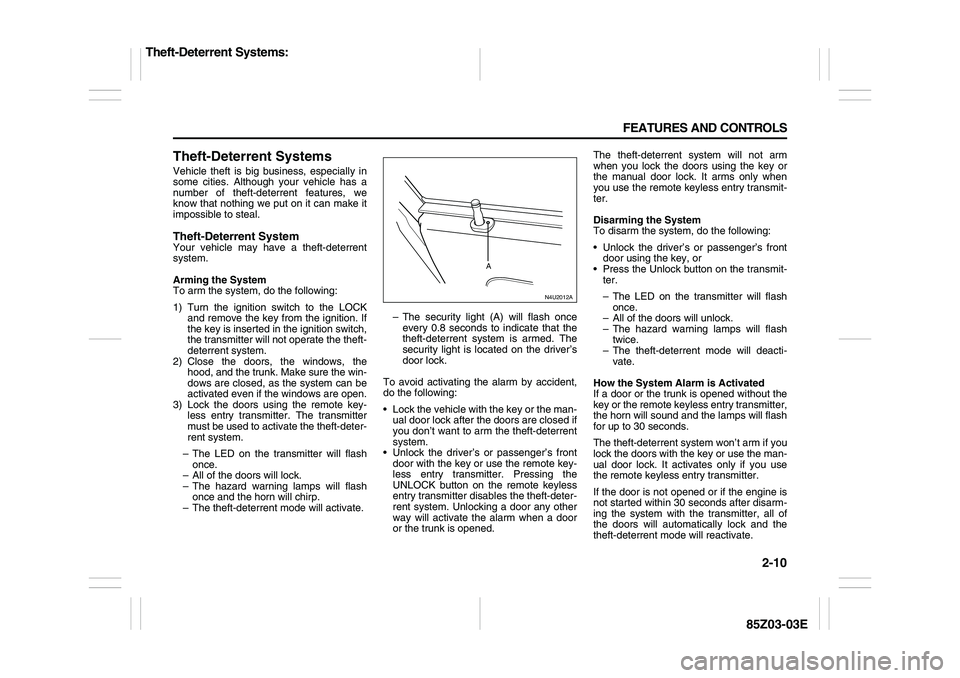
2-10 FEATURES AND CONTROLS
85Z03-03E
Theft-Deterrent SystemsVehicle theft is big business, especially in
some cities. Although your vehicle has a
number of theft-deterrent features, we
know that nothing we put on it can make it
impossible to steal.Theft-Deterrent SystemYour vehicle may have a theft-deterrent
system.
Arming the System
To arm the system, do the following:
1) Turn the ignition switch to the LOCK
and remove the key from the ignition. If
the key is inserted in the ignition switch,
the transmitter will not operate the theft-
deterrent system.
2) Close the doors, the windows, the
hood, and the trunk. Make sure the win-
dows are closed, as the system can be
activated even if the windows are open.
3) Lock the doors using the remote key-
less entry transmitter. The transmitter
must be used to activate the theft-deter-
rent system.
– The LED on the transmitter will flash
once.
– All of the doors will lock.
– The hazard warning lamps will flash
once and the horn will chirp.
– The theft-deterrent mode will activate.– The security light (A) will flash once
every 0.8 seconds to indicate that the
theft-deterrent system is armed. The
security light is located on the driver’s
door lock.
To avoid activating the alarm by accident,
do the following:
Lock the vehicle with the key or the man-
ual door lock after the doors are closed if
you don’t want to arm the theft-deterrent
system.
Unlock the driver’s or passenger’s front
door with the key or use the remote key-
less entry transmitter. Pressing the
UNLOCK button on the remote keyless
entry transmitter disables the theft-deter-
rent system. Unlocking a door any other
way will activate the alarm when a door
or the trunk is opened.The theft-deterrent system will not arm
when you lock the doors using the key or
the manual door lock. It arms only when
you use the remote keyless entry transmit-
ter.
Disarming the System
To disarm the system, do the following:
Unlock the driver’s or passenger’s front
door using the key, or
Press the Unlock button on the transmit-
ter.
– The LED on the transmitter will flash
once.
– All of the doors will unlock.
– The hazard warning lamps will flash
twice.
– The theft-deterrent mode will deacti-
vate.
How the System Alarm is Activated
If a door or the trunk is opened without the
key or the remote keyless entry transmitter,
the horn will sound and the lamps will flash
for up to 30 seconds.
The theft-deterrent system won’t arm if you
lock the doors with the key or use the man-
ual door lock. It activates only if you use
the remote keyless entry transmitter.
If the door is not opened or if the engine is
not started within 30 seconds after disarm-
ing the system with the transmitter, all of
the doors will automatically lock and the
theft-deterrent mode will reactivate.
N4U2012A
A
Theft-Deterrent Systems:
Page 59 of 225

2-11 FEATURES AND CONTROLS
85Z03-03E
How to Turn Off the System Alarm
If the system alarm is active, it can be
deactivated using the following methods:
Press the Lock or Unlock button on the
remote keyless entry transmitter.
Unlock the driver’s or passenger’s front
door using the key.
Otherwise, the alarm will automatically
stop after 30 seconds. The system will
then lock the doors and reactivate the
theft-deterrent system.
How to Detect a Tamper Condition
If the hazard lamps flash once when the
Lock or Unlock button on your transmitter
is pressed, that means the theft-security
system alarm was triggered while you
were away.
Daily Inspection ChecklistBefore Driving1) Make sure that windows, mirrors, lights
and reflectors are clean and unob-
structed.
2) Visually check the tires for the following
points:
– the depth of the tread groove
– abnormal wear, cracks and damage
– loose wheel nuts
– existence of foreign material such as
nails, stones, etc.
Refer to “Tires” in the “SERVICE AND
APPEARANCE CARE” section for details.
3) Look for oil or other fluid leaks.
NOTE:
It is normal for water to drip from the air
conditioning system after use.
4) Make sure the hood is fully closed and
latched.
5) Check the headlights, turn signal lights,
brake lights and horn for proper opera-
tion.
6) Lock all doors.
7) Adjust the seat and adjustable head
restraints (if equipped).
8) Check the brake pedal.
9) Adjust the mirrors.
10)Make sure that you and all passengers
have properly fastened your safety
belts.11)Make sure that all warning lights come
on as the key is turned to the “ON” or
“START” position.
12)Check all gauges.
13)Make sure that the BRAKE light turns
off when the parking brake is released.
Once a week, or each time you fill your fuel
tank, perform the following under-hood
checks:
1) Engine oil level
2) Coolant level
3) Brake fluid level
4) Power steering (if equipped) fluid level
5) Windshield washer fluid level
6) Hood latch operation
Pull the hood release handle inside the
vehicle. Make sure that you cannot
open the hood all the way without
releasing the secondary latch. Be sure
to close the hood securely after check-
ing for proper latch operation. See the
item “Lubricate Locks, Hinges & Hood
Latch” under “Chassis and Body” in the
“MAINTENANCE SCHEDULE” section
for the lubrication schedule.
WARNING
Make sure the hood is fully closed
and latched before driving. If it is not,
it can fly up unexpectedly during
driving, obstructing your view and
resulting in an accident.
Theft-Deterrent Systems:
Daily Inspection Checklist:
Page 60 of 225

2-12 FEATURES AND CONTROLS
85Z03-03E
Starting and Operating Your
VehicleNew Vehicle Break-InIgnition Positions
With the key in the ignition switch, you can
turn the key to four different positions.LOCK:
This position locks your steering wheel,
ignition, automatic transmission shift lever
and automatic transmission. This is the
only position from which you can remove
the key. For easier key operation when
unlocking the steering wheel, move the
steering wheel back and forth while turning
the key to the ACC position.
ACC (ACCESSORY):
This position operates some of your elec-
trical accessories, such as the radio, but
not the ventilation fan. Press in the switch
as you turn it away from you.
ON:
This is the position to which the switch
returns after you start your engine and
release the key. The switch stays in ON
when the engine is running. But even when
the engine is not running, you can use ON
to operate your electrical accessories, and
to display some instrument panel warning
lights.
START:
This position starts the engine. When the
engine starts, release the key. The ignition
switch will return to ON for normal driving.
Do not turn the key to START if the engine
is running.
Even if the engine is not running, ACC and
ON allow you to operate electrical acces-
sories, such as the radio.
CAUTION
Your vehicle doesn’t need an elabo-
rate “break-in.” But it will perform
better in the long run if you follow
these guidelines:
Don’t drive at any one speed – fast
or slow – for the first 500 miles (805
km). Don’t make full-throttle starts.
Avoid making hard stops for the
first 200 miles (322 km) or so. Dur-
ing this time your new brake linings
aren’t yet broken in. Hard stops
with new linings can mean prema-
ture wear and earlier replacement.
Follow this break-in guideline every
time you get new brake linings.
WARNING
On manual transmission vehicles,
turning the key to LOCK and remov-
ing it will lock the steering column
and result in a loss of ability to steer
the vehicle. This could cause a colli-
sion. If you need to turn the engine
off while the vehicle is moving, turn
the key only to ACC. Don’t push the
key in while the vehicle is moving.
CAUTION
If your key seems stuck in LOCK and
you can’t turn it, be sure you are
using the correct key; if so, is it all
the way in? If it is, then turn the steer-
ing wheel left and right while you turn
the key hard. Turn the key only with
your hand. Using a tool to force it
could break the key or the ignition
switch. If none of these works, then
your vehicle needs service.
S4U2015A
Starting and Operating Your Vehicle:
Page 62 of 225
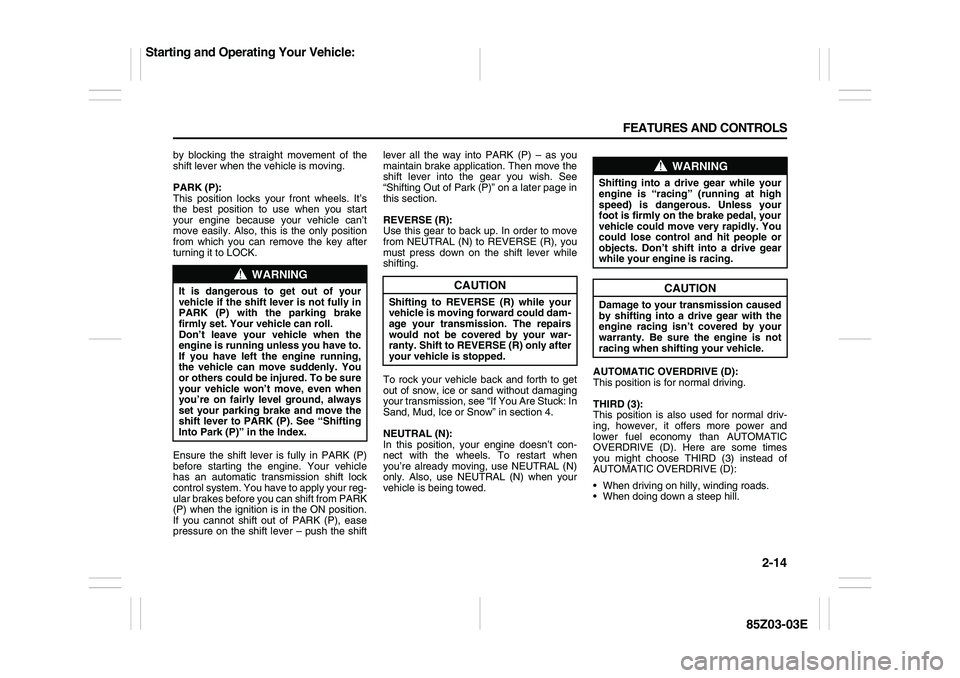
2-14 FEATURES AND CONTROLS
85Z03-03E
by blocking the straight movement of the
shift lever when the vehicle is moving.
PARK (P):
This position locks your front wheels. It’s
the best position to use when you start
your engine because your vehicle can’t
move easily. Also, this is the only position
from which you can remove the key after
turning it to LOCK.
Ensure the shift lever is fully in PARK (P)
before starting the engine. Your vehicle
has an automatic transmission shift lock
control system. You have to apply your reg-
ular brakes before you can shift from PARK
(P) when the ignition is in the ON position.
If you cannot shift out of PARK (P), ease
pressure on the shift lever – push the shiftlever all the way into PARK (P) – as you
maintain brake application. Then move the
shift lever into the gear you wish. See
“Shifting Out of Park (P)” on a later page in
this section.
REVERSE (R):
Use this gear to back up. In order to move
from NEUTRAL (N) to REVERSE (R), you
must press down on the shift lever while
shifting.
To rock your vehicle back and forth to get
out of snow, ice or sand without damaging
your transmission, see “If You Are Stuck: In
Sand, Mud, Ice or Snow” in section 4.
NEUTRAL (N):
In this position, your engine doesn’t con-
nect with the wheels. To restart when
you’re already moving, use NEUTRAL (N)
only. Also, use NEUTRAL (N) when your
vehicle is being towed.AUTOMATIC OVERDRIVE (D):
This position is for normal driving.
THIRD (3):
This position is also used for normal driv-
ing, however, it offers more power and
lower fuel economy than AUTOMATIC
OVERDRIVE (D). Here are some times
you might choose THIRD (3) instead of
AUTOMATIC OVERDRIVE (D):
When driving on hilly, winding roads.
When doing down a steep hill.
WARNING
It is dangerous to get out of your
vehicle if the shift lever is not fully in
PARK (P) with the parking brake
firmly set. Your vehicle can roll.
Don’t leave your vehicle when the
engine is running unless you have to.
If you have left the engine running,
the vehicle can move suddenly. You
or others could be injured. To be sure
your vehicle won’t move, even when
you’re on fairly level ground, always
set your parking brake and move the
shift lever to PARK (P). See “Shifting
Into Park (P)” in the Index.
CAUTION
Shifting to REVERSE (R) while your
vehicle is moving forward could dam-
age your transmission. The repairs
would not be covered by your war-
ranty. Shift to REVERSE (R) only after
your vehicle is stopped.
WARNING
Shifting into a drive gear while your
engine is “racing” (running at high
speed) is dangerous. Unless your
foot is firmly on the brake pedal, your
vehicle could move very rapidly. You
could lose control and hit people or
objects. Don’t shift into a drive gear
while your engine is racing.
CAUTION
Damage to your transmission caused
by shifting into a drive gear with the
engine racing isn’t covered by your
warranty. Be sure the engine is not
racing when shifting your vehicle.
Starting and Operating Your Vehicle:
Page 65 of 225
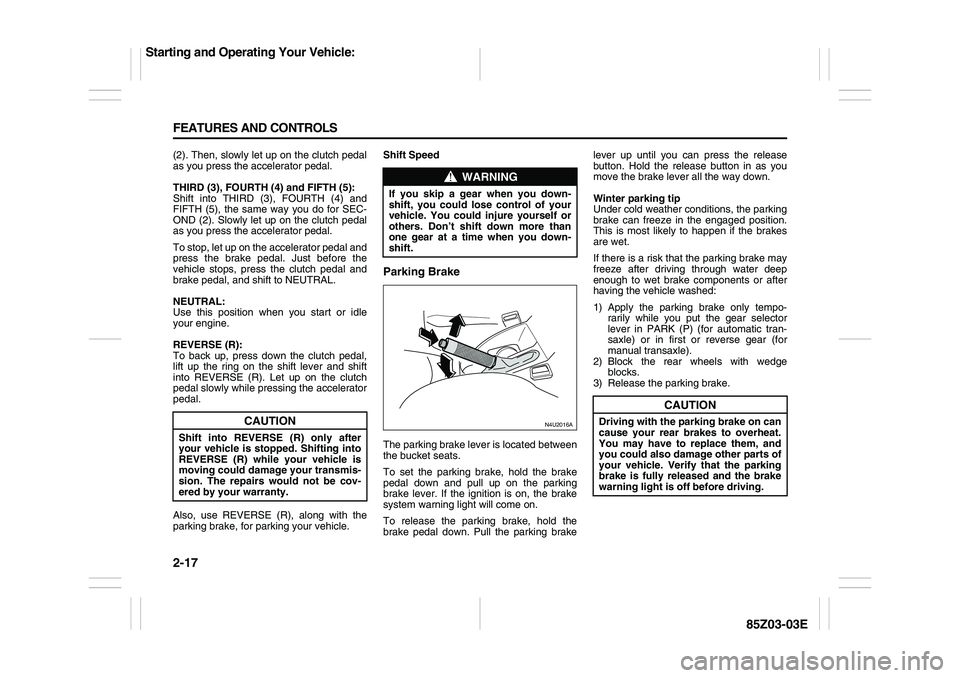
2-17 FEATURES AND CONTROLS
85Z03-03E
(2). Then, slowly let up on the clutch pedal
as you press the accelerator pedal.
THIRD (3), FOURTH (4) and FIFTH (5):
Shift into THIRD (3), FOURTH (4) and
FIFTH (5), the same way you do for SEC-
OND (2). Slowly let up on the clutch pedal
as you press the accelerator pedal.
To stop, let up on the accelerator pedal and
press the brake pedal. Just before the
vehicle stops, press the clutch pedal and
brake pedal, and shift to NEUTRAL.
NEUTRAL:
Use this position when you start or idle
your engine.
REVERSE (R):
To back up, press down the clutch pedal,
lift up the ring on the shift lever and shift
into REVERSE (R). Let up on the clutch
pedal slowly while pressing the accelerator
pedal.
Also, use REVERSE (R), along with the
parking brake, for parking your vehicle.Shift Speed
Parking BrakeThe parking brake lever is located between
the bucket seats.
To set the parking brake, hold the brake
pedal down and pull up on the parking
brake lever. If the ignition is on, the brake
system warning light will come on.
To release the parking brake, hold the
brake pedal down. Pull the parking brakelever up until you can press the release
button. Hold the release button in as you
move the brake lever all the way down.
Winter parking tip
Under cold weather conditions, the parking
brake can freeze in the engaged position.
This is most likely to happen if the brakes
are wet.
If there is a risk that the parking brake may
freeze after driving through water deep
enough to wet brake components or after
having the vehicle washed:
1) Apply the parking brake only tempo-
rarily while you put the gear selector
lever in PARK (P) (for automatic tran-
saxle) or in first or reverse gear (for
manual transaxle).
2) Block the rear wheels with wedge
blocks.
3) Release the parking brake.
CAUTION
Shift into REVERSE (R) only after
your vehicle is stopped. Shifting into
REVERSE (R) while your vehicle is
moving could damage your transmis-
sion. The repairs would not be cov-
ered by your warranty.
WARNING
If you skip a gear when you down-
shift, you could lose control of your
vehicle. You could injure yourself or
others. Don’t shift down more than
one gear at a time when you down-
shift.
N4U2016A
CAUTION
Driving with the parking brake on can
cause your rear brakes to overheat.
You may have to replace them, and
you could also damage other parts of
your vehicle. Verify that the parking
brake is fully released and the brake
warning light is off before driving.
Starting and Operating Your Vehicle:
Page 66 of 225

2-18 FEATURES AND CONTROLS
85Z03-03E
Shifting Into Park (P)
(Automatic Transmission)1) Hold the brake pedal down and set the
parking brake.
2) Move the shift lever into PARK (P) posi-
tion.
3) Turn the ignition key to LOCK.
4) Remove the key and take it with you. If
you can leave your vehicle with the igni-
tion key in your hand, your vehicle is in
PARK (P).Leaving Your Vehicle with the Engine
Running
If you have to leave your vehicle with the
engine running, be sure your vehicle is in
PARK (P) and your parking brake is firmly
set before you leave it. After you’ve moved
the shift lever into PARK (P), hold the regu-
lar brake pedal down. Then, see if you can
move the shift lever away from PARK (P)
without first pushing the button. If you can,
it means that the shift lever wasn’t fully
locked into PARK (P).Torque Lock
If you are parking on a hill and you don’t
shift your transmission into PARK (P) prop-
erly, the weight of the vehicle may put too
much force on the parking pawl in the
transmission. You may find it difficult to pull
the shift lever out of PARK (P). This is
called “torque lock.” To prevent torque lock,
set the parking brake and then shift into
PARK (P) properly before you leave the
driver’s seat. To find out how, see “Shifting
Into Park (P)” in this section.
When you are ready to drive, move the
shift lever out of PARK (P) before you
release the parking brake.
If torque lock does occur, you may need to
have another vehicle push yours a little
uphill to take some of the pressure from
the parking pawl in the transmission, so
you can pull the shift lever out of PARK (P).
Shifting Out of Park (P)
(Automatic Transmission)Your vehicle has a brake transmission shift
interlock system which locks the shift lever
in PARK (P) when the ignition is in the
LOCK position. You have to apply your reg-
ular brakes before you can shift from PARK
(P) when the ignition is in the ON position.
See “Automatic Transmission Operation” in
this section.
If you cannot shift out of PARK (P) while
you hold the brake pedal down, try this:
1) Set the parking brake fully.
WARNING
It is dangerous to get out of your
vehicle if the shift lever is not fully in
PARK (P) with the parking brake
firmly set. Your vehicle can roll. Don’t
leave your vehicle when the engine is
running unless you have to. If you
have left the engine running, the
vehicle can move suddenly. You or
others could be injured. To be sure
your vehicle won’t move, even when
you’re on fairly level ground, use the
steps that follow.
WARNING
It can be dangerous to leave your
vehicle with the engine running. Your
vehicle could move suddenly if the
shift lever is not fully in PARK (P)
with the parking brake firmly set.
And, if you leave the vehicle with the
engine running, it could overheat and
even catch fire. You or others could
be injured. Don’t leave your vehicle
with the engine running.
Starting and Operating Your Vehicle:
Page 67 of 225
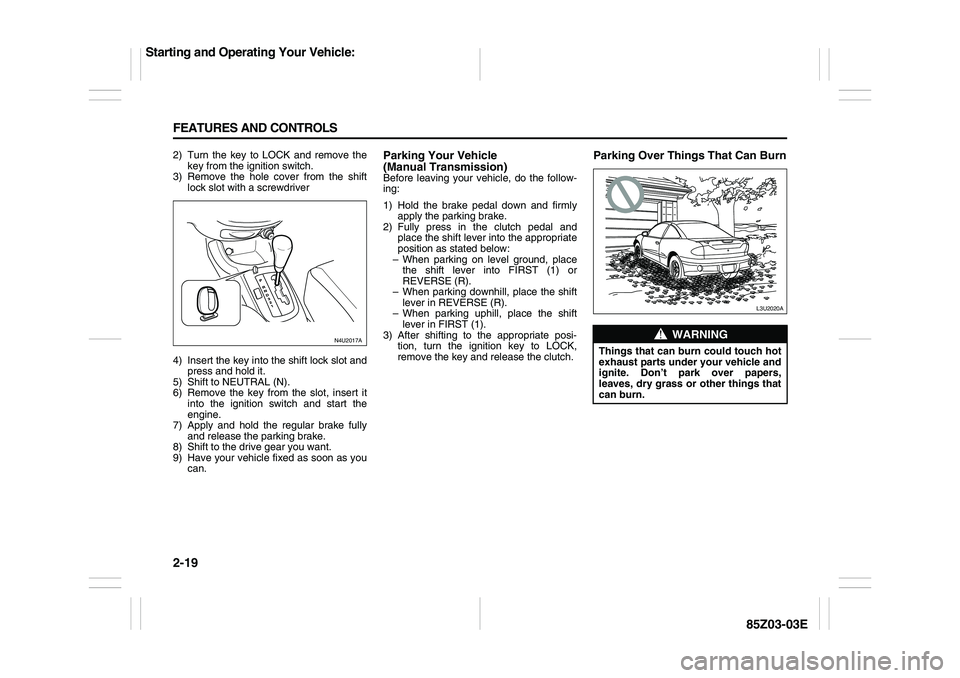
2-19 FEATURES AND CONTROLS
85Z03-03E
2) Turn the key to LOCK and remove the
key from the ignition switch.
3) Remove the hole cover from the shift
lock slot with a screwdriver
4) Insert the key into the shift lock slot and
press and hold it.
5) Shift to NEUTRAL (N).
6) Remove the key from the slot, insert it
into the ignition switch and start the
engine.
7) Apply and hold the regular brake fully
and release the parking brake.
8) Shift to the drive gear you want.
9) Have your vehicle fixed as soon as you
can.
Parking Your Vehicle
(Manual Transmission)Before leaving your vehicle, do the follow-
ing:
1) Hold the brake pedal down and firmly
apply the parking brake.
2) Fully press in the clutch pedal and
place the shift lever into the appropriate
position as stated below:
– When parking on level ground, place
the shift lever into FIRST (1) or
REVERSE (R).
– When parking downhill, place the shift
lever in REVERSE (R).
– When parking uphill, place the shift
lever in FIRST (1).
3) After shifting to the appropriate posi-
tion, turn the ignition key to LOCK,
remove the key and release the clutch.
Parking Over Things That Can Burn
N4U2017A
WARNING
Things that can burn could touch hot
exhaust parts under your vehicle and
ignite. Don’t park over papers,
leaves, dry grass or other things that
can burn.
L3U2020A
Starting and Operating Your Vehicle: